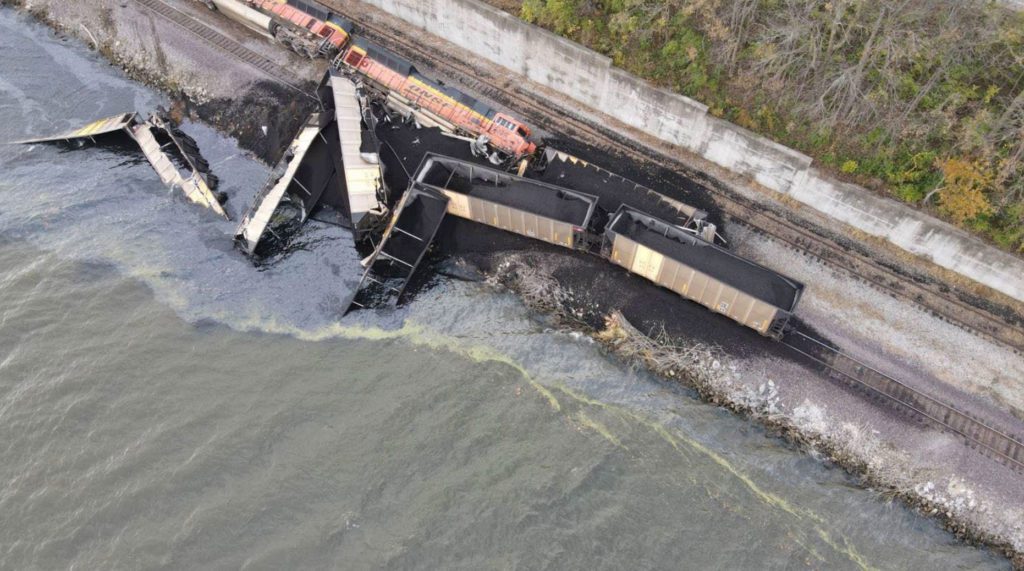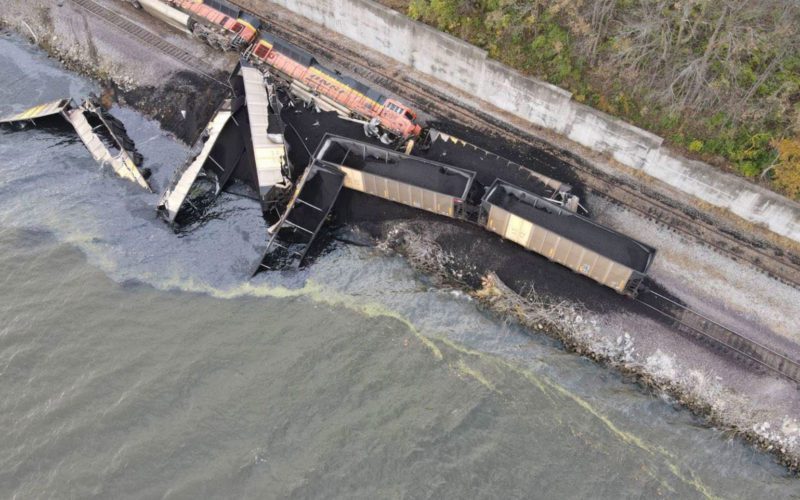
Mississippi River.
Facing strong winds, the 120-foot Baxter Southern pushed its four empty barges against the Upper Mississippi River’s right descending bank near Galland, Iowa. Almost immediately, the towboat’s crew saw the light from a train bearing down on them.
The three mariners on the barges moved to one of the aft vessels and braced for impact while the pilot tried to back the tow away from the riverbank. The engineer on the oncoming BNSF train hit the brakes, but it wasn’t enough to stop the 7,813-foot train in time.
The locomotive struck the port corner of the lead barge at 2343 on Nov. 13, 2021. Two locomotives and 10 hopper cars carrying coal derailed and six ended up in the river. The engineer and conductor suffered minor injuries, while none of the eight mariners on the tow were hurt.
National Transportation Safety Board (NTSB) investigators learned Baxter Southern’s captain and pilot misunderstood symbols on the vessel’s Rose Point electronic chart system (ECS) urging caution. The mariners claimed not to see a separate clickable icon that would have explained the riverbank in that area was unusually close to the railroad tracks.
Their failure to identify the caution area on the ECS was the leading cause of the incident, according to the NTSB.
“While searching the electronic chart on the ECS for an area to push the tow against the shoreline, the captain and pilot stated that they assumed the area marked by a magenta dashed line next to the right descending bank near mile 372 was a fleeting area,” the agency wrote in its incident report. “However, the magenta dashed line actually represented a caution area, which warned of the risk of embankment erosion and of train collision due to the channel’s proximity to the railroad track bed.”
The 55-year-old Baxter Southern left Spechts Ferry, Iowa, on Nov. 9 with four empty barges in a two-and-two formation. The tow was delayed several times due to gusty winds on its voyage to Donaldsonville, La.
The tow got underway from a fuel dock in Pine Bend, Iowa, at 0600 on the morning of the incident. By 2200, the crew struggled to keep a steady heading due to winds gusting up to 45 mph.
Trees and other obstructions along the riverbank left few viable places for the tow to push up between mile 375 and Lock and Dam No. 19 a few miles downriver. The pilot suggested the location at mile 372 where he had seen tows pushed up in the past, the NTSB report said. The pilot and captain consulted the Rose Point system, which placed magenta lines around that area. It also included an exclamation point inside a circle near the dashed marks, also in magenta.
Both the captain and pilot believed those markings denoted a fleeting area — a feature for which there is no special symbol or markings on charts. But based on that misunderstanding, the captain ordered the pilot to push the tow against the bank in that area.
Dashed lines shown in magenta on the Rose Point system indicate an area where caution is warranted, and the exclamation point inside a circle can be clicked to provide more details about the type of hazards within a certain area, the report said. Baxter Southern’s captain and pilot told investigators they did not see the exclamation point symbol.
“The captain and pilot each had over 20 years of experience on the Mississippi River and had extensively used Rose Point over the last several years,” the NTSB report said. “They also had completed training in the operation of Rose Point and interpreting its information. They should have been familiar with the magenta dashed line identifying the caution area and how to query the chart to see additional information about marked areas.”
The report does not identify the captain or the pilot, who had 27 and 32 years of towing experience, respectively. Both completed training on the Rose Point system about 18 months before the incident.
The pilot positioned the tow at a 45-degree angle to the riverbank, facing upriver, with its port lead barge STC 3020 against the bank. The barge’s port rake came to rest within the track bed but not across the tracks. The BNSF train locomotives overhung the tracks on both sides by about two feet.
Three crewmembers aboard the tow were walking toward the head of the tow to inspect its position when they saw the train light some 2,000 feet away. At that point they had only 35 seconds to respond. The train’s two crewmembers saw the tow against the bank about 1,000 feet before impact while traveling at about 37 mph. The train was about 300 feet away when its crew realized the barge extended into the track bed.
The engineer activated emergency brakes on all three locomotives and all 143 hopper cars at 2343. Baxter Southern’s pilot saw the sparks from the emergency brakes and understood the train would not stop in time.
“He put the tug’s engines in full astern to move the tug and (barges) away from the riverbank,” the report said. “However, the engines took 4.5 seconds to respond because of the pneumatic throttle control, delaying the movement of the towing vessel and barges from the riverbank at a time-critical moment.”
The left side of the lead locomotive, BNSF 9031, hit STC 3020 seconds later. The lead locomotive derailed and tipped onto its right side. The second locomotive, BNSF 9251, and 10 hopper cars also left the tracks.
Southern Towing of Memphis owned the 120-foot, 3,300-hp towboat and the lead port barge struck by the train. The company declined to comment on the NTSB findings. •

